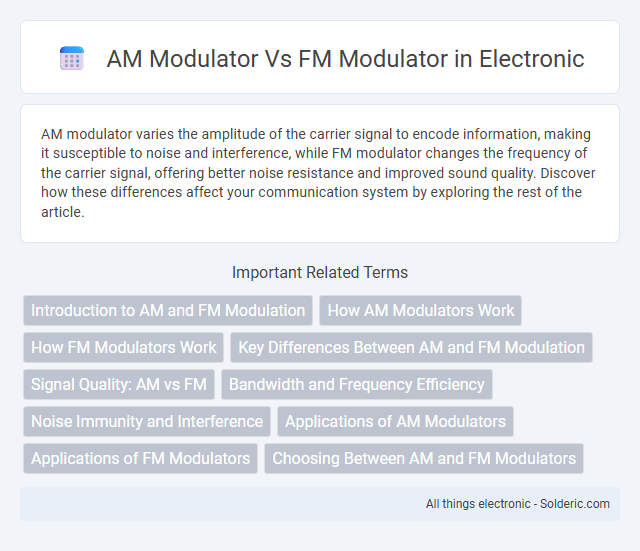AM modulator varies the amplitude of the carrier signal to encode information, making it susceptible to noise and interference, while FM modulator changes the frequency of the carrier signal, offering better noise resistance and improved sound quality. Discover how these differences affect your communication system by exploring the rest of the article.
Comparison Table
| Feature | AM Modulator | FM Modulator |
|---|---|---|
| Modulation Type | Amplitude Modulation | Frequency Modulation |
| Carrier Variation | Amplitude varies | Frequency varies |
| Bandwidth | Narrower bandwidth | Wider bandwidth |
| Sensitivity to Noise | High sensitivity | Low sensitivity |
| Complexity | Simple circuitry | More complex circuitry |
| Power Efficiency | Less efficient | More efficient |
| Used in | AM Radio, Airband | FM Radio, TV audio |
| Signal Quality | Lower audio quality | Higher audio quality |
Introduction to AM and FM Modulation
AM modulators vary the amplitude of the carrier signal in accordance with the input audio signal, emphasizing amplitude changes to encode information. FM modulators change the frequency of the carrier wave based on the input signal while maintaining a constant amplitude, offering greater resistance to noise and signal degradation. Both techniques serve as foundational technologies in analog radio broadcasting, each with unique advantages in signal quality and transmission range.
How AM Modulators Work
AM modulators function by varying the amplitude of a carrier signal in direct proportion to the input audio signal, embedding the information within the amplitude changes while maintaining a constant frequency. This modulation process allows the signal to be transmitted over long distances but is more susceptible to noise and interference due to amplitude variations. The baseband signal modulates the carrier wave's amplitude, which can be demodulated by receivers to extract the original audio information.
How FM Modulators Work
FM modulators work by varying the frequency of the carrier signal in direct proportion to the amplitude of the input audio signal, ensuring improved noise resistance and signal clarity compared to AM modulators. Unlike AM modulators that adjust amplitude, FM modulators maintain constant amplitude, which results in better sound quality and reduced interference in Your transmissions. The technical process involves frequency deviation controlled by the instantaneous voltage of the input signal, making FM modulation ideal for high-fidelity audio broadcasting.
Key Differences Between AM and FM Modulation
AM modulators vary the amplitude of the carrier signal in proportion to the input signal, making them more susceptible to noise and interference, while FM modulators alter the frequency of the carrier signal according to the input signal, resulting in better noise immunity and improved sound quality. AM modulation typically uses simpler technology and is widely applied in long-distance and broadcast radio transmissions, whereas FM modulation offers higher fidelity and is predominantly used in music broadcasting and two-way radio communications. The bandwidth requirement for FM modulation is significantly higher than AM, enhancing signal clarity but increasing spectrum usage.
Signal Quality: AM vs FM
FM modulators provide superior signal quality compared to AM modulators due to their resilience against static and noise interference, which preserves audio fidelity in varying transmission conditions. AM modulators are more susceptible to amplitude fluctuations caused by electrical storms and other environmental factors, resulting in degraded signal clarity. The frequency modulation technique used in FM modulators ensures a higher signal-to-noise ratio, making FM the preferred choice for high-fidelity broadcasting.
Bandwidth and Frequency Efficiency
AM modulators require a bandwidth twice the highest frequency of the transmitted signal, resulting in lower frequency efficiency compared to FM modulators, which use a narrower bandwidth due to frequency deviation control. FM modulators can transmit signals with greater noise immunity and better spectral efficiency by concentrating transmitted power within a specific frequency range. Your choice of modulator impacts bandwidth allocation and overall frequency efficiency, making FM modulation preferable for applications demanding superior spectrum utilization.
Noise Immunity and Interference
FM modulators exhibit superior noise immunity compared to AM modulators, as frequency modulation inherently reduces the impact of amplitude-based noise and interference. AM modulators are more susceptible to static and electromagnetic interference because their signal amplitude directly carries information, making any amplitude variations problematic. In environments with high electromagnetic noise, FM modulation ensures clearer signal transmission and reception, enhancing overall communication reliability.
Applications of AM Modulators
AM modulators are extensively used in broadcasting, particularly for AM radio transmissions where long-range signal coverage is essential. They are also preferred in aviation communication systems to ensure reliable voice transmission under varying atmospheric conditions. Furthermore, AM modulation finds applications in two-way radios and amplitude shift keying (ASK) systems for transmitting digital signals over short distances.
Applications of FM Modulators
FM modulators are widely used in radio broadcasting, providing high-fidelity sound with reduced noise and interference compared to AM modulators. They are essential in commercial FM radio stations, two-way radios, and wireless communication systems where signal clarity and resistance to amplitude noise are critical. FM modulators also play a vital role in telemetry, satellite communication, and audio transmission in cordless devices.
Choosing Between AM and FM Modulators
Choosing between AM and FM modulators depends on your signal transmission requirements and environmental conditions. AM modulators offer simplicity and compatibility for long-distance communication but are more susceptible to noise and interference, while FM modulators provide superior signal quality and resistance to interference at the cost of increased complexity and bandwidth usage. Your choice should prioritize whether clarity or range is more critical for your application, considering factors like terrain, potential interference, and bandwidth availability.
AM modulator vs FM modulator Infographic

 solderic.com
solderic.com